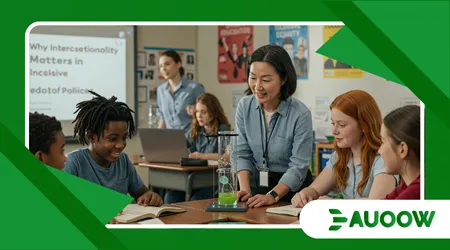Why Intersectionality Matters in Inclusive Education Policies

Intersectionality weaves a complex tapestry of identities, shaping how students experience education. In 2025, inclusive education policies must embrace this lens to ensure equity.
Every student carries unique identities race, gender, disability, socioeconomic status that intersect, creating distinct challenges and opportunities.
Ignoring these overlaps risks perpetuating exclusion. This article explores why intersectionality is pivotal in crafting policies that truly serve all learners, leveraging assistive technology and innovation to foster equitable education systems.
The urgency for inclusive education has never been clearer.
UNESCO’s 2023 Global Education Monitoring Report revealed that 258 million children were out of school before the COVID-19 pandemic, with marginalized groups particularly those with disabilities, from minority ethnic backgrounds, or living in poverty disproportionately affected.
Intersectionality demands we see these overlapping vulnerabilities, ensuring policies address not just one identity but their combined impact.
By integrating assistive technologies, schools can personalize learning, but only if policies reflect the nuanced realities of diverse student populations.
Why settle for surface-level inclusion when we can build systems that truly uplift every learner?
Understanding Intersectionality in Education
Intersectionality, a term coined by Kimberlé Crenshaw in 1989, describes how overlapping identities create unique experiences of privilege or oppression.
In education, it reveals why a one-size-fits-all approach fails. A Black girl with a visual impairment, for instance, faces barriers distinct from a white boy with the same disability.
Policies ignoring these intersections risk overlooking her specific needs, like culturally responsive braille resources.
Consider Maria, a fictional 14-year-old Latina student with autism in a rural U.S. school. Her language barrier, cultural background, and disability intersect, complicating her access to assistive communication tools.
Without policies addressing these overlaps, Maria’s education suffers. Schools must tailor interventions to her unique profile, not just her disability.
++ Inclusive Gaming: How Developers Are Building for Everyone
Data underscores this need. A 2024 study in Education Sciences found that students with multiple marginalized identities face higher exclusion rates, emphasizing intersectionality’s role in policy design.
Policies must account for these layered identities to ensure equitable access.
The classroom is a microcosm of society. If we ignore intersectionality, we perpetuate systemic inequities, leaving students like Maria behind.
Policies must reflect the complexity of real-world identities to be truly inclusive.

The Role of Assistive Technology in Addressing Intersectionality
Assistive technology (AT) can bridge gaps for students with disabilities, but intersectionality demands more nuanced applications.
AT must adapt to diverse identities, not just disabilities. For example, AI-driven speech-to-text tools help students with motor impairments, but language barriers require multilingual options for non-English speakers.
Take Ahmed, a 16-year-old refugee with hearing loss. His school provides a hearing aid, but without Arabic-language captioning software, he struggles.
Intersectionality highlights how his refugee status and disability intersect, demanding tailored AT solutions. Schools must prioritize culturally and linguistically responsive tools.
Also read: Why Mainstream Tech Needs Built-In Accessibility from Day One
A 2023 review in IEEE Access noted that AT like AI-powered augmentative communication devices enhances inclusion for students with specific learning difficulties.
Yet, without an intersectional lens, these tools may exclude students with additional marginalizations. Policies must ensure AT is adaptable to diverse needs.
Imagine a puzzle with missing pieces. Each student’s identity is a piece, and AT must fit them all together. Policies ignoring intersectionality leave gaps, undermining inclusion.
The challenge lies in implementation. Teachers need training to select AT that addresses intersectional needs, ensuring tools like predictive text or virtual reality learning platforms are accessible across cultures and languages.
Policies must fund such training to maximize AT’s impact.
Policy Gaps and the Need for Intersectional Frameworks
Current education policies often focus on single-axis issues, like disability or poverty, neglecting intersectionality.
This leaves students with multiple marginalized identities underserved. For instance, policies may fund wheelchairs but ignore how rural students access them.
Read more: Exoskeletons and Mobility: Where We Are in 2025
In low-income countries, only 5–15% of children with disabilities have access to AT, per a 2015 UNICEF report. When gender or ethnicity compounds disability, access drops further.
Policies must integrate intersectionality to address these disparities, prioritizing marginalized groups.
| Identity Factor | Barrier | Intersectional Solution |
|---|---|---|
| Disability + Poverty | Limited AT access | Fund mobile AT units for rural areas |
| Disability + Gender | Gendered stigma in tech use | Gender-neutral AT design and training |
| Disability + Ethnicity | Language barriers | Multilingual AT interfaces |
This table illustrates how intersectional policies can address specific barriers, ensuring equitable AT distribution. Without such frameworks, policies remain incomplete.
Consider the analogy of a road system. Single-axis policies build one-lane roads, but intersectional frameworks create highways accommodating all travelers. Why limit ourselves to narrow paths?
Global initiatives, like the World Bank’s 2024 Inclusive Education Approach Paper, advocate for context-specific policies that consider intersectionality. Governments must adopt these principles, ensuring AT reaches those at identity crossroads.
Innovations Driving Intersectional Inclusion
Emerging technologies offer transformative potential for inclusive education, but only if guided by intersectionality.
AI, augmented reality, and generative tools can personalize learning, yet they must account for diverse identities.
For example, AI task managers help students with executive function challenges, but cultural biases in algorithms can exclude minority students.
Vanderbilt University’s 2025 Planning Assistant project uses AI to break down assignments into subtasks, aiding students with disabilities.
Yet, for a Native American student with dyslexia, culturally relevant content is crucial. Policies must ensure such innovations are inclusive.
Real-time transcription tools, like those on Zoom, enhance accessibility for deaf students.
But for a deaf student from a low-income background, policies must ensure affordable internet access. Intersectionality guides these solutions, ensuring no one is left behind.
Innovations must be scalable. Mobile AT units can reach remote areas, but policies must fund them. Intersectional frameworks ensure these tools serve diverse populations effectively.
The question remains: Can we afford to ignore intersectionality when technology offers such potential for equity? Policies must drive innovation toward inclusive outcomes.
Challenges and Ethical Considerations
Implementing intersectional policies faces hurdles. Teacher training, funding, and algorithmic bias in AT pose significant challenges.
Teachers often lack skills to use AT for diverse student needs, and budgets rarely prioritize intersectional solutions.
Ethical concerns also arise. AI-driven AT can perpetuate biases if not designed inclusively.
A 2025 report from Every Learner Everywhere highlighted risks of algorithmic bias in AI tools, potentially excluding students with intersecting identities. Policies must mandate bias audits for AT.
Resistance to change is another barrier. Schools may prioritize cost over equity, sidelining intersectional needs. Advocacy from communities, including parents and disability organizations, is crucial to push for systemic change.
Funding disparities exacerbate these issues. Wealthier districts often access advanced AT, while poorer ones lag. Policies must allocate resources equitably, prioritizing marginalized groups.
Collaboration is key. Engaging stakeholders students, teachers, and communities ensures policies reflect real-world needs. Intersectional frameworks thrive on collective input, fostering inclusive solutions.

A Call to Action for 2025 and Beyond
Intersectionality is not a buzzword it’s a blueprint for equitable education. As we navigate 2025, policies must embrace this lens to ensure no student is left behind.
Assistive technology, from AI to augmented reality, holds immense potential, but only if guided by intersectional principles.
Policymakers must act now. Fund teacher training, prioritize multilingual and culturally responsive AT, and engage communities in policy design.
The World Bank’s 2024 call for disability-inclusive education by December 2025 is a start, but it must include intersectional frameworks.
Students like Maria and Ahmed deserve education systems that see their whole selves.
By weaving intersectionality into policies, we build a future where every learner thrives. Let’s commit to highways, not one-lane roads, for inclusive education.
The journey to equity is complex but achievable. With intersectional policies, assistive technology can transform education, ensuring every student’s unique identity is celebrated and supported. Will we rise to the challenge?
Frequently Asked Questions
What is intersectionality in the context of education?
Intersectionality refers to how overlapping identities (e.g., race, disability, gender) create unique experiences, requiring tailored educational policies.
How does assistive technology support intersectional inclusion?
Assistive technology, like AI-driven tools, can personalize learning but must address diverse identities, such as multilingual options for non-English speakers.
What are the biggest challenges in implementing intersectional policies?
Challenges include teacher training, funding shortages, and algorithmic biases in assistive technology, which can exclude students with multiple marginalized identities.
How can schools ensure equitable access to assistive technology?
Schools should adopt intersectional policies, fund culturally responsive tools, and engage communities to ensure equitable distribution and use of assistive technology.
